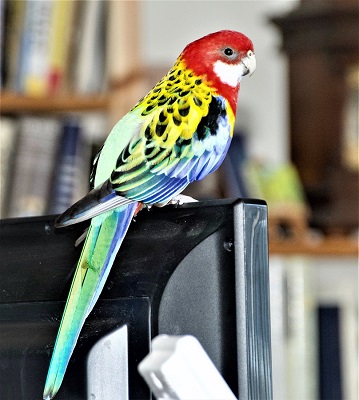
They’re bold and they’re beautiful, but we aren’t talking about characters in a soap opera. No, these colourful characters are eastern rosellas and they were our Animal of the Month for July. But now that July is almost over, it’s time for our featured creatures to fly out of the spotlight. We hope you enjoyed following us on Twitter @ExoticPetVets as we tweeted all month long about the eastern rosella. But in case you missed any of our tweets, you can always find a summary right here. Did you know?:
- The eastern rosella (Platycercus eximius) is one of six species of rosella parrots native to Australia. In the wild, the eastern rosella is found throughout southeastern Australia and on the island of Tasmania.
- Eastern rosellas are an invasive species in New Zealand, having been introduced there in the early 1900’s. They are now commonly found all over New Zealand.
- In New Zealand feral eastern rosellas compete with indigenous birds for food and nesting sites, and there’s a concern that they can spread disease. There are also reports that they damage agricultural crops.
- The problem of invasive species is so bad in New Zealand that as of Sept. 1, 2022, the breeding and selling of a number of non-native exotic species will be banned in Auckland as part of the city’s pest management plan – and that includes the eastern rosella.
- In the wild, eastern rosellas live in a wide variety of habitats, including forest edges, open woodlands, savannas, grasslands, orchards and farmland.
- Eastern rosellas have also adapted to living side-by-side with humans in urban and suburban areas and can be found in residential gardens, parks and even on golf courses.
- Considered a medium-sized parrot, adult eastern rosellas measure an average of 30 cm (12 inches) from tip to tail.
- Eastern rosellas are known for their brilliantly-coloured plumage. One of their most distinctive characteristics is their bright red heads with their signature white patches on their cheeks.
- The red feathers on the eastern rosella’s head extends down onto the upper part of his chest, creating a “bib” effect. The lower chest is yellow which gives way to green on his abdomen.
- The feathers on the napes and backs of eastern rosellas are black with yellow-green edging that creates a striking scalloped pattern.
- Eastern rosellas have wings in two shades of blue. The shorter feathers on the upper part of their wings (their shoulders) are light blue while the rest of their wings are dark blue.
- Eastern rosellas have light green feathers on their lower backs, which give way to long tails that are nearly as long as their body length. The upper part of the middle tail feathers are green while the outer feathers are dark blue with light blue tips.
- Eastern rosellas have light grey or horn-coloured beaks. They have rings around their dark brown eyes that are a darker grey. Their legs and feet are also dark grey.
- Female eastern rosellas look very similar to their male counterparts, but there are some key differences. They are generally smaller and their feathers are duller in colour. They also have a whitish stripe under their wings that males don’t have.
- Given their bold appearance, it may be hard to believe that eastern rosellas are remarkably good at disappearing into their surroundings.
- Despite the eastern rosellas’ bright colours, their patterned plumage actually creates an effective camouflage that helps them evade predators.
- The main predators of eastern rosellas include large birds of prey along with domestic cats and dogs.
- The relationship wild eastern rosellas have with humans is a bit of a double-edged sword. Humans are their predators because they poach them for the pet trade.
- So many species suffer from human-caused deforestation. But since eastern rosellas tend to live in more open habitats, they seem to benefit from forest degradation because it is increasing their livable areas.
- ‘Til death do they part. Eastern rosellas are monogamous and form life-long pair bonds.
- Female eastern rosellas reach reproductive age at about 18 months; while males take a little longer to mature, reaching sexual maturity at between two and three years of age.
- Breeding season for wild eastern rosellas is usually August to February. They typically nest in existing tree cavities, but will occasionally use old burrows or nest boxes.
- The clutch size for eastern rosellas can range from two to nine eggs. The female is solely in charge of incubating the eggs and her mate will feed her as she is on the nest.
- It takes about three weeks for eastern rosella eggs to hatch. The female will feed the hatchlings exclusively for their first two weeks of life. After that, the male will play a more active role in feeding them for the next two weeks.
- Eastern rosella chicks spend a little over a month in the nest and become independent at between six to eight weeks of age.
- The diet of wild eastern rosellas mostly consists of seeds. They will also eat fruits, shoots, leaves, buds, insects, flowers and nectar.
- Wild eastern rosellas often feed on the ground, but will also forage for food in bushes and trees.
- Wild eastern rosellas will forage for food in small informal flocks that are usually made up of around 8-20 birds. But during breeding season, they will either forage alone or in pairs.
- Eastern rosellas in the wild live an average of about 15 years. With proper care, eastern rosellas in captivity can live about 25 years.

